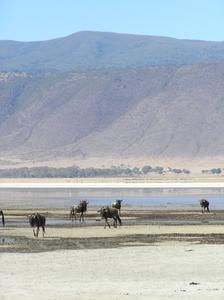Advertisement
Published: November 6th 2005

 Ngorogoro crater
Ngorogoro crater
Wildebeast in the Ngorogoro craterFrom Kenya we headed south to Tanzania on the truck. There were 17 of us on the trip. All Australian apart from one New Zealander and 2 Brits. As we trundled along I loved watching the changing scenery. Kenya was lush and green but as we neared the border it grew drier with bare soil, acacia trees and russet mountains in the distance. The rural areas were more sparsely populated. Everywhere was dusty and dust was to be with us - in clothes, hair, shoes and tents - for most of the rest of the journey.
Our main stop in Tanzania was the Ngorogoro crater. A spectacular early morning drive took us to the rim of the crater where we could look down into the dry bleached centre. The road then meanders steeply down the inside of the rim into the crater itself which is 23km diameter bowl of soda lakes and savanna. The animals here do not migrate. We had some excellent views of lions stalking prey, hippos wallowing in the shallow lakes and two cheetahs lounging in the grass. At lunchtime we were dive bombed by the resident kite population who were eager to steal any sandwiches or

 Zanzibar boats
Zanzibar boats
Boats on a tropical islandchicken legs that were held in sight.
The next day was a long drive across Tanzania to the coast and Dar-es-Salaam. Overland tours are a mix of days with activity - game drives or adreneline sports, interspersed with long lazy days on the truck sleeping, reading and eating. In the tarpauline sided truck, depending on which seat you sit, you are alternately blown away by the wind or roasted by the sun. When the truck pulls into a campsite everyone has about 45 minutes to put up a tent and sort out their belongings. Main packs are kept on the truck for security and so not to overcrowd the tents. However this means that everything needed for the night and next day has to be fished out of these packs and kept in day packs. The group is divided into teams for cooking, washing up and cleaning the truck on a rota.
We pulled into the campsite at Dar well after dark after catching a ferry seething with people heading home for the night. I decided to upgrade into a hut on the shore with the soothing sound of waves lapping all night. The next morning we packed

 shark
shark
Shark fin out of waterquickly and headed to the ferry for the two hour crossing to Zanzibar.
Stonetown on Zanzibar is a maze of narrow lanes and colonal houses. Cars and people fight for space in the narrow lanes and I nearly ended up in hospital again when I couldn't get out of the way of an on-coming 4x4. There is some lovely craftwork on Zanzibar. Particularly the tinga-tinga animal paintings. Behind the light and touristy nature of Stonetown today is the gruesome history of the slave trade. On a tour of slave history and spices we visited the small dungeons where slaves were tested for their endurance. If they survived several nights crammed and chained together in the confined space and a flogging the next day they were fit to sell on by the arab traders. The slave trade was officially abolished in 1875 but continued illegally for many more years. The tour continued with a visit to some of the spice plantations inland.
Then followed three idyllic days on the beach. Turquoise seas, blue seas and white sand. I managed to devise a cover for my cast consisting of a rubber glove, and duct tape to keep out the water and I managed to snorkel although I apparently looked a bit like a shark with my black covered had held up out of the water.
The boat trip back to the mainland was very rough. Some of the girls had bought strange anti-seasickness pills at a pharmacy on Zanzibar just in case and were comatose for the two hour trip.
Next stop Malawi.
Advertisement
Tot: 0.047s; Tpl: 0.009s; cc: 13; qc: 17; dbt: 0.0284s; 1; m:domysql w:travelblog (10.17.0.13); sld: 1;
; mem: 1.1mb

 Ngorogoro crater
Ngorogoro crater
 Zanzibar boats
Zanzibar boats
 shark
shark